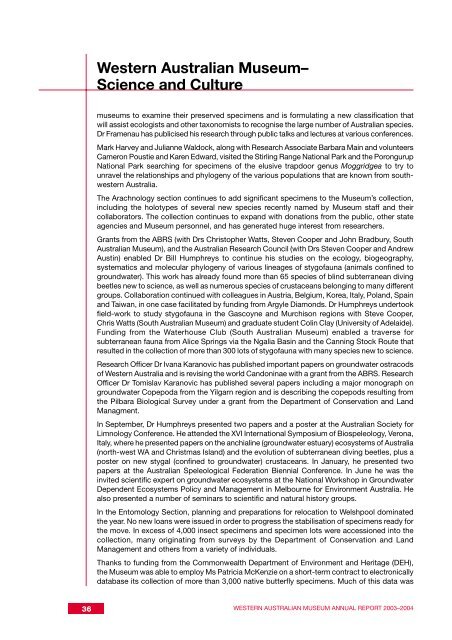Western Australian Museum Annual Report 2003-2004
Western Australian Museum Annual Report 2003-2004
Western Australian Museum Annual Report 2003-2004
You also want an ePaper? Increase the reach of your titles
YUMPU automatically turns print PDFs into web optimized ePapers that Google loves.
36<br />
<strong>Western</strong> <strong>Australian</strong> <strong>Museum</strong>–<br />
Science and Culture<br />
museums to examine their preserved specimens and is formulating a new classification that<br />
will assist ecologists and other taxonomists to recognise the large number of <strong>Australian</strong> species.<br />
Dr Framenau has publicised his research through public talks and lectures at various conferences.<br />
Mark Harvey and Julianne Waldock, along with Research Associate Barbara Main and volunteers<br />
Cameron Poustie and Karen Edward, visited the Stirling Range National Park and the Porongurup<br />
National Park searching for specimens of the elusive trapdoor genus Moggridgea to try to<br />
unravel the relationships and phylogeny of the various populations that are known from southwestern<br />
Australia.<br />
The Arachnology section continues to add significant specimens to the <strong>Museum</strong>’s collection,<br />
including the holotypes of several new species recently named by <strong>Museum</strong> staff and their<br />
collaborators. The collection continues to expand with donations from the public, other state<br />
agencies and <strong>Museum</strong> personnel, and has generated huge interest from researchers.<br />
Grants from the ABRS (with Drs Christopher Watts, Steven Cooper and John Bradbury, South<br />
<strong>Australian</strong> <strong>Museum</strong>), and the <strong>Australian</strong> Research Council (with Drs Steven Cooper and Andrew<br />
Austin) enabled Dr Bill Humphreys to continue his studies on the ecology, biogeography,<br />
systematics and molecular phylogeny of various lineages of stygofauna (animals confined to<br />
groundwater). This work has already found more than 65 species of blind subterranean diving<br />
beetles new to science, as well as numerous species of crustaceans belonging to many different<br />
groups. Collaboration continued with colleagues in Austria, Belgium, Korea, Italy, Poland, Spain<br />
and Taiwan, in one case facilitated by funding from Argyle Diamonds. Dr Humphreys undertook<br />
field-work to study stygofauna in the Gascoyne and Murchison regions with Steve Cooper,<br />
Chris Watts (South <strong>Australian</strong> <strong>Museum</strong>) and graduate student Colin Clay (University of Adelaide).<br />
Funding from the Waterhouse Club (South <strong>Australian</strong> <strong>Museum</strong>) enabled a traverse for<br />
subterranean fauna from Alice Springs via the Ngalia Basin and the Canning Stock Route that<br />
resulted in the collection of more than 300 lots of stygofauna with many species new to science.<br />
Research Officer Dr Ivana Karanovic has published important papers on groundwater ostracods<br />
of <strong>Western</strong> Australia and is revising the world Candoninae with a grant from the ABRS. Research<br />
Officer Dr Tomislav Karanovic has published several papers including a major monograph on<br />
groundwater Copepoda from the Yilgarn region and is describing the copepods resulting from<br />
the Pilbara Biological Survey under a grant from the Department of Conservation and Land<br />
Managment.<br />
In September, Dr Humphreys presented two papers and a poster at the <strong>Australian</strong> Society for<br />
Limnology Conference. He attended the XVI International Symposium of Biospeleology, Verona,<br />
Italy, where he presented papers on the anchialine (groundwater estuary) ecosystems of Australia<br />
(north-west WA and Christmas Island) and the evolution of subterranean diving beetles, plus a<br />
poster on new stygal (confined to groundwater) crustaceans. In January, he presented two<br />
papers at the <strong>Australian</strong> Speleological Federation Biennial Conference. In June he was the<br />
invited scientific expert on groundwater ecosystems at the National Workshop in Groundwater<br />
Dependent Ecosystems Policy and Management in Melbourne for Environment Australia. He<br />
also presented a number of seminars to scientific and natural history groups.<br />
In the Entomology Section, planning and preparations for relocation to Welshpool dominated<br />
the year. No new loans were issued in order to progress the stabilisation of specimens ready for<br />
the move. In excess of 4,000 insect specimens and specimen lots were accessioned into the<br />
collection, many originating from surveys by the Department of Conservation and Land<br />
Management and others from a variety of individuals.<br />
Thanks to funding from the Commonwealth Department of Environment and Heritage (DEH),<br />
the <strong>Museum</strong> was able to employ Ms Patricia McKenzie on a short-term contract to electronically<br />
database its collection of more than 3,000 native butterfly specimens. Much of this data was<br />
WESTERN AUSTRALIAN MUSEUM ANNUAL REPORT <strong>2003</strong>–<strong>2004</strong>
















